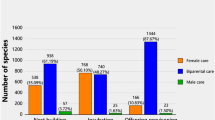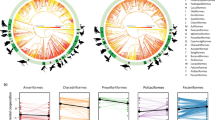Abstract
Squabbles and squawks are a common feature of avian family life, so it is no wonder that birds are model species for the study of parent–offspring conflict. But how much do these behaviours really tell us about the evolutionary conflicts of interest between parents and their young? Here, we provide a brief review that is aimed primarily at ornithologists not already familiar with this area of research.
Similar content being viewed by others
References
Alexander RD (1974) The evolution of social behavior. Annu Rev Ecol Syst 5:325–383
Anderson DJ (1995) The role of parents in siblicidal brood reduction of two booby species. Auk 112:860–869
Brown LH, Urban EK (1969) The breeding biology of the great white pelican Pelecanus onocrotalus roseus at lake Shala, Ethiopia. Ibis 111:199–237
Buchanan KL, Catchpole CK (1997) Female choice in the sedge warbler, Acrocephalus schoenobaenus: multiple cues from song and territory. Proc R Soc Lond B 264:521–526
Burke VEM, Brown LH (1970) Observations on the breeding of the pink-backed pelican. Ibis 112:499–512
Cash KJ, Evans RM (1986) Brood reduction in the American white pelican (Pelecanus erythrorhynchos). Behav Ecol Sociobiol 18:413–418
Chapman FM (1908) Camps and cruises of an ornithologist. Appleton, New York
Clotfelter ED, Schubert KA, Nolan V, Ketterson ED (2003) Mouth color signals thermal state of nestling dark-eyed juncos (Junco hyemalis). Ethology 109:171–182
Din NA, Eltringham SK (1974) Breeding of the pink-backed pelican Pelecanus rufescens in Rwenzori National Park, Uganda, with notes on a colony of marabou storks Leptoptilus crumeniferus. Ibis 116:477–493
Dorward DF (1962) The comparative biology of the white booby and the brown booby Sula spp. at ascension. Ibis 103: 174–200
Drummond H (2001) A revaluation of the role of food in broodmate aggression. Anim Behav 61:517–526
Drummond H (2002) Begging versus aggression in avian broodmate competition. In: Wright J, Leonard ML (eds) The evolution of begging: competition, cooperation and communication. Kluwer, Dordrecht
Drummond H (2006) Dominance in vertebrate broods and litters. Q Rev Biol 81:3–32
Drummond H, Rodríguez C, Vallarino A, Valderrábano C, Rogel G, Tobón E (2003) Desperado siblings: uncontrollably aggressive junior chicks. Behav Ecol Sociobiol 53:287–296
Evans RM (1994) Cold-induced calling and shivering in young American white pelicans: honest signalling of offspring need for warmth in a functionally integrated thermoregulatory system. Behaviour 129:13–34
Evans RM, Weibe MO, Lee SC, Bugden SC 1995 Embryonic and parental preferences for incubation temperature in herring gulls: implications for parent–offspring conflict. Behav Ecol Sociobiol 36:17–23
Forbes LS (1993) Avian brood reduction and parent–offspring “conflict”. Am Nat 142:82–117
Forbes S, Thornton S, Glassey B, Buckley NJ (1997) Why parent birds play favourites. Nature 390:351–352
Frith CB, Beehler BM (1998) The birds of paradise. Oxford University Press, Oxford
Fujioka M (1985) Food delivery and sibling competition in experimentally even-aged broods of the cattle egret. Behav Ecol Sociobiol 17:67–74
Godfray HCJ (1991) Signalling of need by offspring to their parents. Nature 352:328–330
Godfray HCJ (1995) Evolutionary theory of parent–offspring conflict. Nature 376:133–138
Godfray HCJ (1999) Parent–offspring conflict. In: Keller L (ed) Levels of selection in evolution. Princeton University Press, Princeton
Godfray HCJ, Harper AB (1990) The evolution of brood reduction by siblicide in birds. J Theor Biol 145:163–175
Godfray HCJ, Johnstone RA (2000) Begging and bleating: the evolution of parent–offspring signalling. Philos Trans R Soc Lond B Biol Sci 355:1581–1591
Gorman HE, Nager RG (2004) Prenatal developmental conditions have long-term effects on offspring fecundity. Proc R Soc Lond B 271:1923–1928
Grafen A (1990) Biological signals as handicaps. J Theor Biol 144:517–546
Haywood S, Perrins CM (1992) Is clutch size in birds affected by environmental conditions during growth? Proc R Soc Lond B 249:195–197
Hinde CA (2006) Negotiation over offspring care? A positive response to partner-provisioning rate in great tits. Behav Ecol 17:6–12
Horn AG, Leonard ML (2002) Efficacy and the design of begging signals. In: Wright J, Leonard ML (eds) The evolution of begging: competition, co-operation and communication. Kluwer, Dordrecht
Horsfall J (1984) Brood reduction and brood division in coots. Anim Behav 32:216–225
Hunt S, Kilner RM, Langmore NE, Bennett ATD (2003) Conspicuous, ultraviolet-rich mouth colours in begging chicks. Proc R Soc Lond B 270:S25–S28
Ingram C (1920) A contribution to the study of nestling birds. Ibis, 10th series 2:856–880
Jourdie V, Moureau B, Bennett ATD Heeb P (2004) Ultraviolet reflectance by the skin of nestlings. Nature 431:262
Kilner R (1997) Mouth colour is a reliable signal of need in begging canary nestlings. Proc R Soc Lond B 264:963–968
Kilner RM (2006) Function and evolution of color in young birds. In: Hill G, McGraw K (eds) Bird coloration. Harvard University Press, London
Kilner RM, Davies NB (1998) Nestling mouth colour: ecological correlates of a begging signal. Anim Behav 56:705–712
Kilner RM, Noble DG, Davies NB (1999) Signals of need in parent–offspring communication and their exploitation by the cuckoo. Nature 397:667–672
de Kogel CH, Prijs HJ (1996) Effects of brood size manipulations on sexual attractiveness of offspring in the zebra finch. Anim Behav 51:699–708
Krebs JR, Dawkins R (1984) Animal signals: mind-reading and manipulation. In: Krebs JR, Davies NB (eds) Behavioural ecology: an evolutionary approach. Blackwell, Oxford
Langmore NE, Hunt S, Kilner RM (2003) Escalation of a co-evolutionary arms race through host rejection of brood parasitic young. Nature 422:157–160
Layne JN (1982) Status of sibling aggression in Florida sandhill cranes. J Field Ornithol 53:272–274
Leonard ML, Horn AG (2001a) Begging calls and parental feeding decisions in tree swallows (Tachycineta bicolor). Behav Ecol Sociobiol 49:170–175
Leonard ML, Horn AG (2001b) Dynamics of calling by tree swallow (Tachycineta bicolor) nestmates. Behav Ecol Sociobiol 50:430–435
Leonard ML, Horn AG (2005) Ambient noise and the design of begging signals. Proc R Soc Lond B 272:651–656
Leonard ML, Horn AG (2006) Age-related changes in signalling of need by nestling tree swallows (Tachycineta bicolor). Ethology 112:1020–1026
Lougheed LW, Anderson D J (1999) Parent blue-footed boobies suppress siblicidal behavior of offspring. Behav Ecol Sociobiol 45:11–18
Lyon BE, Eadie JM, Hamilton LD (1994) Parental choice selects for ornamental plumage in American coot chicks. Nature 371:240–243
Macnair MR, Parker GA (1978) Models of parent–offspring conflict. 2. Promiscuity. Anim Behav 26:111–122
Macnair MR, Parker GA (1979) Models of parent–offspring conflict. III. Intra-brood conflict. Anim Behav 27:1202–1209
Magrath RD (1990) Hatching asynchrony in altricial birds. Biol Rev 95:587–622
Magrath RD (1991) Nestling weight and juvenile survival in the blackbird Turdus merula. J Anim Ecol 60:335–351
McDonald DB, Potts WK 1994 Co-operative display and relatedness among males in a lek-mating bird. Science 266:1030–1032
Meyburg BU (1974) Sibling aggression and mortality among nestling eagles. Ibis 116:224–228
Mock DW (1987) Siblicide, parent–offspring conflict and unequal parental investment by egrets and herons. Behav Ecol Sociobiol 20:247–256
Mock DW, Parker GA (1986) Advantages and disadvantages of ardeid brood reduction. Evolution 40:459–470
Mock DW, Parker GA (1997) The evolution of sibling rivalry. Oxford University Press, Oxford
Mock DW, Ploger BJ (1987) Parental manipulation of optimal hatch asynchrony in cattle egrets: an experimental study. Anim Behav 35:150–160
Mulder RA, Magrath MJL (1994) Timing of prenuptial molt as a sexually selected indicator of male quality in superb fairy-wrens (Malarus cyaneus). Behav Ecol 5:393–400
Nager RG, Monaghan P, Houston DC (2000) Within-clutch trade-offs between the number and quality of eggs: experimental manipulations in gulls. Ecology 81:1339–1350
Nelson JB (1978) The Sulidae: gannets and boobies. Oxford University Press, London
O’Connor RJ (1978) Brood reduction in birds:selection for fratricide, infanticide, and suicide. Anim Behav 26:79–96
Osorno JL, Drummond H (1995) The function of hatching asynchrony in the blue-footed booby. Behav Ecol Sociobiol 37:265–273
Parker GA, Macnair MR (1978) Models of parent–offspring conflict. 1. Monogamy. Anim Behav 26:97–110
Parker GA, Macnair MR (1979) Models of parent–offspring conflict. IV. Suppression and evolutionary retaliation by the parent. Anim Behav 27:1210–1235
Parker GA, Royle NJ, Hartley IR (2002) Begging scrambles with unequal chicks: interactions between need and competitive ability. Ecol Lett 5:206–215
Petrie M, Halliday T (1994) Experimental and natural changes in the peacock’s (Pave cristatus) train can affect mating success. Behav Ecol Sociobiol 35:213–217
Pierrotti R (1991) Infanticide versus adoption—an intergenerational conflict. Am Nat 138:1140–1158
Pinson D, Drummond H (1993) Brown pelican siblicide and the prey-size hypothesis. Behav Ecol Sociobiol 32:111–118
Procter DLC (1975) The problem of chick loss in the South Polar skua Catharacta maccormicki. Ibis 117:452–459
Redondo T, Castro F (1992) Signalling of nutritional need by magpie nestlings. Ethology 92:193–204
Rowe EG (1947) The breeding biology of Aquila verreauxi (Lesson). Ibis 89:576–606
Royle NJ, Hartley IR, Parker GA (2002) Begging for control: when are offspring solicitation behaviours honest? Trends Ecol Evol 17:434–440
Saino N, Ninni P, Calza S, Martinelli R, De Bernardi F, Møller AP (2000) Better red than dead: carotenoid based mouth colouration reveals infection in barn swallow nestlings. Proc R Soc Lond B 267:57–61
Saino N, Galeotti P, Sacchi R, Boncoraglio G, Martinelli R, Møller AP (2003) Sex differences in begging vocalizations of nestling barn swallows, Hirundo rustica. Anim Behav 66:1003–1010
Schaller GB (1964) Breeding behavior of the white pelican at Yellowstone Lake, Wyoming. Condor 66:3–23
Schuetz JG (2005) Low survival of parasite chicks may result from their imperfect adaptation to hosts rather than expression of defenses against parasitism. Evolution 59:2017–2024
Schwabl H, Mock DW, Gieg J (1997) A hormonal mechanism for parental favouritism. Nature 386:231
Siegfried WR (1972) Breeding success and reproductive output of the cattle egret. Ostrich 43:43–55
Tortosa FS, Redondo T (1992) Motives for parental infanticide in white storks Ciconia ciconia. Ornis Scand 23:185–189
Trivers RL (1974) Parent–offspring conflict. Am Zool 14:249–264
Urrutia LP, Drummond H (1990) Brood reduction and parental infanticide in Heermann’s Gull (Larus heermanni). Auk 107:772–774
Vestjens WJM (1977) Breeding behavior and ecology of the Australian pelican, Pelecanus conspicilatus, in New South Wales. Aust Wildl Res 4:37–58
Young EC (1963) The breeding behaviour of the South Polar skua, Catharacta maccormicki. Ibis 105:203–233
Young EC, Miller CD (2003) Siblicidal brood reduction in South Polar skuas. NZ J Zool 30:79–93
Acknowledgments
We thank Kate Lessells for encouraging us to organise a symposium at the IOC, the other participants (Lars Hillstrom, Petra Quillfeldt and Ruedi Nager) for their interesting contributions, Susan Hannon for her flexibility in programming the symposium, and Franz Bairlein and the other members of the IOC Organizing Committee for a stimulating and enjoyable meeting in Hamburg. We are very grateful to Martin Fowlie for his comments on the manuscript. R.M.K. was supported by a Royal Society University Research Fellowship and H.D. by an UNAM PAPIIT scholarship.
Author information
Authors and Affiliations
Corresponding author
Additional information
Communicated by F. Bairlein.
Rights and permissions
About this article
Cite this article
Kilner, R.M., Drummond, H. Parent–offspring conflict in avian families. J Ornithol 148 (Suppl 2), 241–246 (2007). https://doi.org/10.1007/s10336-007-0224-3
Received:
Revised:
Accepted:
Published:
Issue Date:
DOI: https://doi.org/10.1007/s10336-007-0224-3




